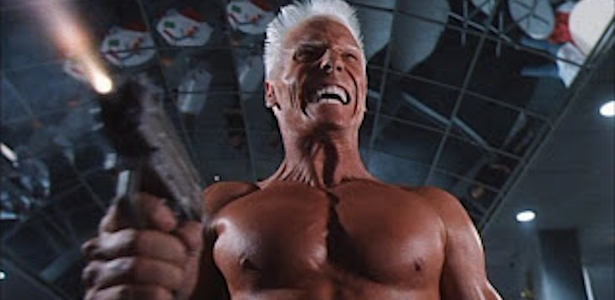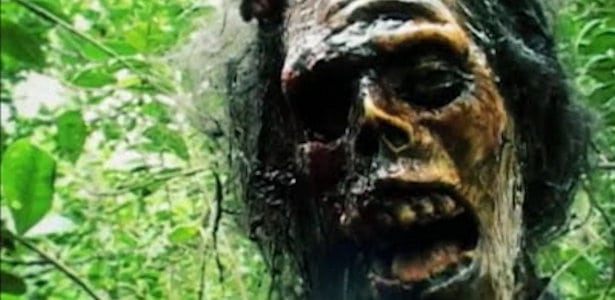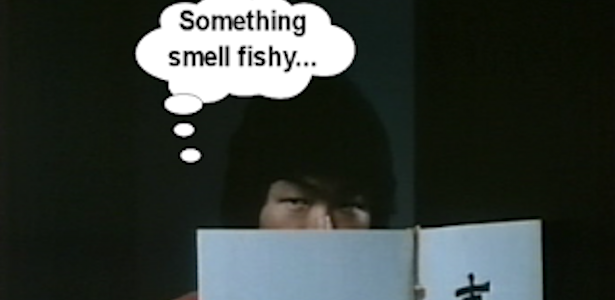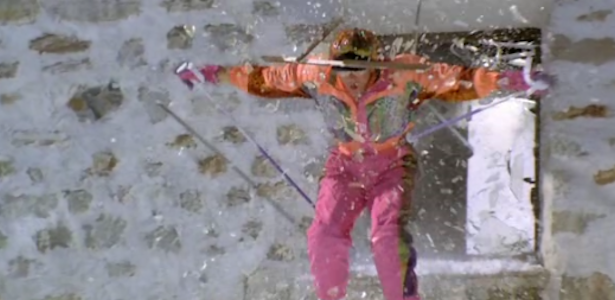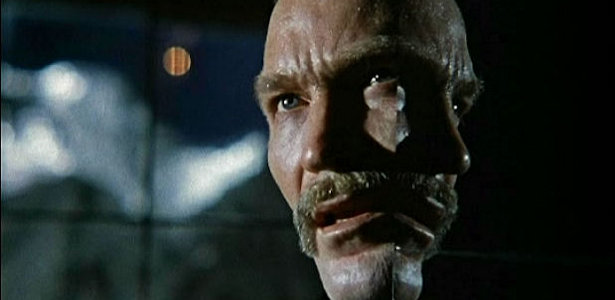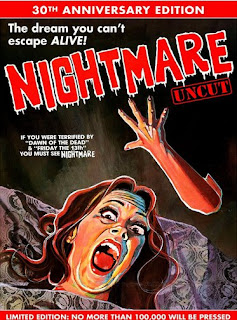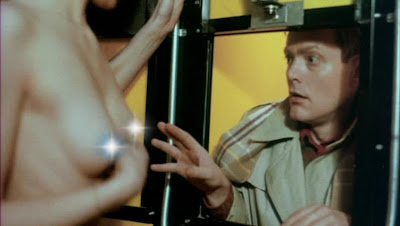"The past is a foreign country: they do things differently there."
1982 might not seem that long ago. But in Hollywood-years, 1982 might as well be a billion light years ago. Back then, the film business hadn’t yet succumbed to the kind of distribution hegemony we see today, where something with a $10 million dollar budget is considered low-budget and major studios have an “independent film” label. Nowhere was this more apparent than in the horror genre. The slasher era was just beginning, and the horror genre had yet to fall into the abyss littered with sequels, remakes and remakes of sequels where it resides today. John Carpenter’s HALLOWEEN (1978) had become the most successful independent movie of all-time and a quick glance at any random Variety “Top 50 Box Office” listings shows independent productions such as SCARED TO DEATH (1981) and DEMON RAGE (1982) trying to following suit. Ambitious and independent filmmakers, simply put, actually stood a chance when it came to getting a production both off the ground and into theaters.
Perhaps the biggest boost these self-reliant filmmakers got came from the early issues of Fangoria. Entering into its fourth year in 1982, the growing horror film magazine certainly wasn’t above promoting the little guy, as evidenced by issues where they threw Lucio Fulci’s ZOMBIE (1979) or William Lustig’s MANIAC (1980) on the cover. Co-editors “Uncle” Bob Martin and David Everitt recognized not only the diversity within the genre, but championed the belief that the finest filmmakers started at ground level and outside of the studio system. This is mostly evident in the feature story about “The Grisly Independents” that adorned the cover of issue #17. Penned by Martin, the article profiled three independent horror films in various states of production – monster madness THE DEADLY SPAWN, sorority slasher PRANKS (aka THE DORM THAT DRIPPED BLOOD) and horror anthology BLOODY PULP.
No doubt I read this piece back as a 7-year-old kid and, like a lot of readers, promptly forgot about it. After all, of the three films profiled, BLOODY PULP seemed the furthest from completion (interestingly, both THE DEADLY SPAWN and THE DORM THAT DRIPPED BLOOD have seen DVD releases from Synapse Films in the ensuing years). The film didn’t register again on my brainwaves until earlier this year when poster Dave Jay asked about the film on the AV Maniacs message board. Oh yeah, I remember that movie; the one with the black zombie that reminded me of SUGAR HILL (1974). Being somewhat obsessed with films that never got made, I dug out my weathered issue of the magazine and read the one-page write up on the film.
As Mr. Jay mentioned in his post, there is absolutely zero information online about this film. Type it into Google and the only mention you will get is the aforementioned thread. Literally the only ink spilled on the film appears to be this nearly 30-year-old article. That, my misguided brain said, is not acceptable. Thankfully, the four filmmakers mentioned in the piece (Thomas Doran, Frank Farel, Brendan Faulkner and Paul Levine) had rather unique names and – with the help of Bill Picard, the Internet’s Greatest Detective – I was able to get in touch with BLOODY PULP co-creator Thomas Doran. After probably saying to himself, “Who the hell is this weirdo asking about an unfinished film from 1982,” Doran responded to my initial email. Genial and beyond helpful, Doran was not only willing to discuss the project, but he was also in touch with fellow co-creator Frank Farel. Farel turned out to be as equally accommodating and both men agreed to share the story behind the story; the journey toward and the non-making of BLOODY PULP.
Like most filmmakers, Doran and Farel started their obsessions at a young age and horror figured in prominently into their youthful endeavors.
Video Junkie: Were you horror fans (movies, EC comics, etc.) growing up?
Thomas Doran: Yes, horror fan going back to the 50's. HOUSE ON HAUNTED HILL for example, with Emergo, was great, 13 GHOSTS, BRIDES OF DRACULA, and all of those days in the theater. We literally lived in the theaters in those days. Not just horror of course, but there was always something good to see. Devoured Famous Monsters and Screen Thrills, et all.
Frank Farel: We were all what I can only call fanatical horror fans -- myself, seriously, from the age of 11 or 12 when I got a hold of the Boris Karloff memorial issue of Famous Monsters of Filmland. Movies and TV (Universal, Hammer & AIP classics, The Outer Limits, etc.), fiction (Lovecraft, Poe, Bradbury, Bloch, so many others), comics (EC & Warren) -- I eagerly absorbed it all. That's continued to this day.
VJ: What sort of background did you have in film-making leading up to BLOODY PULP?
TD: Been making films since I was 11. The typical kid takes on horror, superhero films. The usual thing every kid gets into when they start to make films so young. All 8mm (pre super 8); and then moved into 16mm when I was 16 and tried to make an Errol Flynn/Republic serial hybrid feature! What was I thinking? Never finished, but lots of film I still have - and frankly a couple of remarkable stunts - even for 16 and 17 year olds. Did some other things in high school, but drifted more into art and music in the 70's. Brendan brought me back into film in the 70's.
FF: I got my first super 8 camera as a Christmas gift when I was twelve. Instantly went out and made a vampire film. I was fortunate enough to attend a high school that offered a "Cinematography" class, which I took for two years, making two award-winning comedy shorts. I met Brendan Faulkner, then Tom Doran, through a summer school film class I at the State University at Purchase, New York.
It was during this time in the SUNY system under the tutelage of Roy Frumkes (DOCUMENT OF THE DEAD; STREET TRASH) that Farel and Faulkner learned an important lesson about the film business. And, inadvertently, they received confirmation that their filmmaking was commercially acceptable as segments of a film they directed ended up opening the Italian import ZOMBIE HOLOCAUST, which distributor Aquarius Releasing ushered into theaters in 1981 under the more well-known moniker DOCTOR BUTCHER, M.D. (1980).
VJ: Can you tell me how your footage made it into the U.S. release of DOCTOR. BUTCHER, M.D.?
FF: Brendan and I had directed uncompleted stories for another unfinished horror anthology, TALES THAT WILL TEAR YOUR HEART OUT. Footage from both our sequences in TALES eventually showed up, much to our surprise, in the title sequences for the Italian zombie horror DOCTOR. BUTCHER, M.D.
TD: I was [partially] responsible for Aquarius getting a hold of the footage from Frumkes. I went to them to try and get funding for a project Frank and I were pitching. TALES came up in the conversation - they were mainly interested because of Wes Craven having directed an episode. There was talk of them finishing the film, and I put them in touch with Roy - with the proviso that I get to direct an episode. He laughed - it never happened, but they obviously got a hold of some of the footage and used it - strangely, neither Frank nor Brendan, who directed the used footage, received screen credit.
 FF: To supplement what Tom already said -- yes, Roy Frumkes sold the TALES footage to Aquarius Releasing honcho Terry Levine without the knowledge of Brendan Faulkner, myself or anyone else (including investors) connected to the production. Aquarius changed the title ZOMBIE HOLOCAUST to DOCTOR BUTCHER, M.D. because the original title was too similar to CANNIBAL HOLOCAUST, which had then recently been in theaters. This was some time after Terry had mulled over financing the completion of TALES -- and Roy informed me he didn't want to do business with Levine because he didn't trust him. I assume this changed when a cash offer for a couple of minutes of footage was made.
FF: To supplement what Tom already said -- yes, Roy Frumkes sold the TALES footage to Aquarius Releasing honcho Terry Levine without the knowledge of Brendan Faulkner, myself or anyone else (including investors) connected to the production. Aquarius changed the title ZOMBIE HOLOCAUST to DOCTOR BUTCHER, M.D. because the original title was too similar to CANNIBAL HOLOCAUST, which had then recently been in theaters. This was some time after Terry had mulled over financing the completion of TALES -- and Roy informed me he didn't want to do business with Levine because he didn't trust him. I assume this changed when a cash offer for a couple of minutes of footage was made.
Frumkes, to our disbelief, gave himself sole screen credit - though all footage used was created entirely by Brendan and myself. We found out retroactively and, needless to say, were not pleased - though I must say it was kinda cool having my "big screen debut" with footage I'd directed at the age of 19. I remember seeing it in one of the 42nd Street grindhouses.
Knowing that their work was up to snuff for the discerning crowds on America’s most infamous movie-going street, the filmmakers set about on starting their own feature. As part of a filmmaking collective, the four men decided to attempt an anthology. Long a favorite format of horror fans due to classics ranging from DEAD OF NIGHT (1945) to Amicus’ TALES FROM THE CRYPT (1972), the anthology would provide the best route for all four filmmakers to showcase their talents. Interestingly, independent horror mainstay George A. Romero was filming an anthology, CREEPSHOW (1982), at the same time as our fledgling filmmakers, proving they had their finger on the pulse of the genre.
VJ: How did the BLOODY PULP idea come about?
FF: The earliest framework for this anthology concept went under the title FREAK SHOW, with an introduction and bridging sequences at a carnival sideshow. With the change to BLOODY PULP I wrote a surrounding story involving a trio of criminals fleeing a robbery, finding refuge in a decrepit book store filled with crumbling old pulp magazines where the oddball owner provides intros to the various stories.
VJ: What was the budget on this feature?
TD: I have no memory of that to be honest. The one episode filmed was around $5,000 up till the point it ended - though that would have gone up of course just for that episode. It wasn't really budgeted - at some level, when films are so cheap, you film with whatever scraps of coin you come up with. If you thought about it too hard, nothing would have gotten done, ever.
FF: I don't think there ever was a real budget on paper. We were shooting the first episode "Double Cross" with financing supplied by its original director [Paul Levine], who also owned some camera equipment. Costs were usually pretty contained.
VJ: In the Fangoria profile piece, it is mentioned that “Double Cross” was put on hold. Did this segment ever get finished?
TD: Never finished.
FF: "Double Cross" was halted when we parted ways with its original director, but our intentions were to continue with the project. Several sequences having already been shot, it was briefly decided that I would complete this episode. I even did a rewrite of the script with that in mind.
VJ: Where were the finished portions filmed?
TD: We filmed at a state park in upstate New York (for the scenes involving a Caribbean island of all things); where we transported, by rented truck, the "ruins" of an ancient stone temple that I designed and built - in order to film in the middle of a very long night. A very dark night too. We also filmed at an airport in Connecticut. We filmed with a 1947 seaplane in Montrose or Buchanan, New York for scenes, again, of one of the characters escape, with a corpse, from the temple scene. Filmed at a funeral home in Port Chester, New York.
FF: As mentioned by Tom, we did some scenes at a large funeral home in Port Chester, New York where a mortician (and film-making enthusiast) friend of ours allowed us to film. He and his family also lived there. Perfect location for what we were doing. Lovely interiors and access to the embalming chambers.
VJ: If you can recall, what were the titles of the two other segments?
TD: I can't remember either. Brendan or Frank might possibly know.
FF: I don't remember the titles either. Brendan's, I believe, involved a secret society composed of ghouls.
VJ: Did either of these segments or the wrap-around get started filming?
TD: No, all written, some story-boarded; production design, etc., but no filming.
FF: As Tom said, nothing but portions of "Double Cross" made it before the cameras
VJ: Any interesting anecdotes about the film (casting, filming or reactions from folks who saw some of it)?
TD: The ruins of the ancient "stone" temple caught on fire in the middle of the night - but that was probably the only really exciting thing that happened of any interest. On one other occasion, one of the actors, determined NOT to run into the whirling rear blade of the sea plane (a smart idea), instead ran into the wing, knocking him senseless. But we have that on film at least.
FF: The burning of the ancient temple is also my own major memory of the production. An all night shoot at Bear Mountain State Park, miles off the main road in the middle of nowhere with deafening gas generators for power. I don't even recall us getting permission to shoot. As dawn rolled around the "stone pillars" (spray-painted aluminum foil over flimsy frames. Surprisingly good illusion!) caught fire and burned to the ground before the night's filming was completed.
VJ: What kept BLOODY PULP from being finished?
TD: The answer, most simply put, was the usual - money, and some on-set kookiness that often bedevils films. On micro-budget films, that can be deadly as there's little fallback room. We were shooting on film, so, costs were not so low - even on the cheap, if you know what I mean.
Ultimately, the “temporary hold” that the filmmakers put on the project turned into a permanent one. As mentioned in the article, Doran, Farel and Faulkner went to work as film doctors on another New York film named BLOODSHED (ultimately re-titled and released by Troma as IGOR AND THE LUNATICS). The trio would re-team one more time for producer Michael Lee on TWISTED SOULS, which eventually came out as SPOOKIES.
VJ: Did the work on BLOODY PULP lead to the job for TWISTED SOULS/SPOOKIES?
TD: No, not at all. Initially Brendan and I went to work on a film called BLOODSHED (IGOR AND THE LUNATICS once Troma got a hold of it); we were consultants at first, then did some writing, lighting, and directing of the film - we also ended up acting in it. It consumed a lot of time - but was fun. Met a lot of great folks. It's a really nice memory. This happened concurrently with BLOODY PULP.
What we did after that was make a very elaborate show-reel for a feature we wanted to do called HELLSPAWN. It was very ambitious - lots of effects work, floor effects and optical; set pieces; demon monster suits, even sword fights for God's sake; special make-up effects, and more; all to attract potential backers. That footage was seen by the backer who in the end got us all involved in TWISTED SOULS - but that was in no way related to HELLSPAWN conceptually - which was a much better script to be sure. We didn't have a lot of control over the story elements of TWISTED SOULS - story concepts and set pieces were essentially dictated to us by the financial backer - and we tried to turn that into something interesting, but it ended up as something not very original at all. We tried, tied hands and all, but we would have made a far nicer film if we had been allowed to do HELLSPAWN.
FF: As Tom more or less relates, what really kept us from completing BLOODY PULP was that other projects came along. Most filmmakers are generally writing and pushing several projects at once and are usually ready, out of necessity, to jump ship for the most promising opportunity. And yes, HELLSPAWN would have been a much better movie than SPOOKIES.
For anyone wondering exactly how BLOODY PULP might have looked, they can turn their attention to SPOOKIES. As mentioned in the article, Doran’s proposed segment (“Deadlier Than the Male”) dealt with a woman who was literally a man-eater. Unable to resist such a delicious concept, Doran carried over portions of his PULP story into the monster heavy TWISTED SOULS.
VJ: Did the man-eater story work its way into TWISTED SOULS/SPOOKIES (the spider woman)?
TD: The Spider Woman in TWISTED SOULS was a direct offshoot from BLOODY PULP. The design was initially the same as well, but got changed during TWISTED SOULS - and frankly, not necessarily for the better. But a lot of people seem to like it.
Spider minion artwork
by Thomas Doran:
In the end, BLOODY PULP was a movie not to be. Post-shutdown, the Doran-Farel-Faulkner trio remained active in film with the aforementioned BLOODSHED (aka IGOR AND THE LUNATICS) and TWISTED SOULS (aka SPOOKIES). Doran has remained busy using his considerable artistic talents to do storyboards and design props. He has also worked steadily in industrial videos and recently completed the rock band documentary MOTHER OF MERCY, IS THIS THE END OF DOUBLESPEAK? (2011). He is also actively developing a new horror film based on the Sawney Bean story and more info on that can be found here. Farel would go on to be the Associate Producer on the cult classic STREET TRASH (1987) and currently is a writer-producer-director at Soundview Broadcasting. And a few years after TWISTED SOULS, Faulkner would also direct the feature THE KILLER DEAD (aka NON-VEGETARIAN ZOMBIES FROM OUTER SPACE), which is currently unreleased. Despite continued careers in the entertainment industry, the BLOODY PULP still sits in Doran and Farel’s minds.
writer-producer-director at Soundview Broadcasting. And a few years after TWISTED SOULS, Faulkner would also direct the feature THE KILLER DEAD (aka NON-VEGETARIAN ZOMBIES FROM OUTER SPACE), which is currently unreleased. Despite continued careers in the entertainment industry, the BLOODY PULP still sits in Doran and Farel’s minds.
VJ: Ever have any thoughts of tackling the material again? Or releasing what you did film?
TD: I actually, in a moment of madness, suggested to Frank and Brendan that we should do an anthology film and use the same title - it's a decent title actually for that type of film - but not necessarily to use any of the original concepts. Certainly not any of the original 1981 footage (after all neither Frank, Brendan or myself directed any of “Double Cross”) - but we didn't give it any really serious consideration.
FF: As Tom says, no thoughts of trying to do anything with the old material, though the title really does deserve a movie.
*Special note: All of the still images from the BLOODY PULP shoot were shot by Thomas Sciacca. Also, several years after this post, The Dissolve did a detailed breakdown on the making of SPOOKIES, which is definitely recommended and can be read at this link.
– L.P. Hartley’s novel The Go-Between (1953)
Perhaps the biggest boost these self-reliant filmmakers got came from the early issues of Fangoria. Entering into its fourth year in 1982, the growing horror film magazine certainly wasn’t above promoting the little guy, as evidenced by issues where they threw Lucio Fulci’s ZOMBIE (1979) or William Lustig’s MANIAC (1980) on the cover. Co-editors “Uncle” Bob Martin and David Everitt recognized not only the diversity within the genre, but championed the belief that the finest filmmakers started at ground level and outside of the studio system. This is mostly evident in the feature story about “The Grisly Independents” that adorned the cover of issue #17. Penned by Martin, the article profiled three independent horror films in various states of production – monster madness THE DEADLY SPAWN, sorority slasher PRANKS (aka THE DORM THAT DRIPPED BLOOD) and horror anthology BLOODY PULP.
The original article (click to enlarge):
No doubt I read this piece back as a 7-year-old kid and, like a lot of readers, promptly forgot about it. After all, of the three films profiled, BLOODY PULP seemed the furthest from completion (interestingly, both THE DEADLY SPAWN and THE DORM THAT DRIPPED BLOOD have seen DVD releases from Synapse Films in the ensuing years). The film didn’t register again on my brainwaves until earlier this year when poster Dave Jay asked about the film on the AV Maniacs message board. Oh yeah, I remember that movie; the one with the black zombie that reminded me of SUGAR HILL (1974). Being somewhat obsessed with films that never got made, I dug out my weathered issue of the magazine and read the one-page write up on the film.
As Mr. Jay mentioned in his post, there is absolutely zero information online about this film. Type it into Google and the only mention you will get is the aforementioned thread. Literally the only ink spilled on the film appears to be this nearly 30-year-old article. That, my misguided brain said, is not acceptable. Thankfully, the four filmmakers mentioned in the piece (Thomas Doran, Frank Farel, Brendan Faulkner and Paul Levine) had rather unique names and – with the help of Bill Picard, the Internet’s Greatest Detective – I was able to get in touch with BLOODY PULP co-creator Thomas Doran. After probably saying to himself, “Who the hell is this weirdo asking about an unfinished film from 1982,” Doran responded to my initial email. Genial and beyond helpful, Doran was not only willing to discuss the project, but he was also in touch with fellow co-creator Frank Farel. Farel turned out to be as equally accommodating and both men agreed to share the story behind the story; the journey toward and the non-making of BLOODY PULP.
Like most filmmakers, Doran and Farel started their obsessions at a young age and horror figured in prominently into their youthful endeavors.
Video Junkie: Were you horror fans (movies, EC comics, etc.) growing up?
Thomas Doran: Yes, horror fan going back to the 50's. HOUSE ON HAUNTED HILL for example, with Emergo, was great, 13 GHOSTS, BRIDES OF DRACULA, and all of those days in the theater. We literally lived in the theaters in those days. Not just horror of course, but there was always something good to see. Devoured Famous Monsters and Screen Thrills, et all.
Frank Farel: We were all what I can only call fanatical horror fans -- myself, seriously, from the age of 11 or 12 when I got a hold of the Boris Karloff memorial issue of Famous Monsters of Filmland. Movies and TV (Universal, Hammer & AIP classics, The Outer Limits, etc.), fiction (Lovecraft, Poe, Bradbury, Bloch, so many others), comics (EC & Warren) -- I eagerly absorbed it all. That's continued to this day.
VJ: What sort of background did you have in film-making leading up to BLOODY PULP?
TD: Been making films since I was 11. The typical kid takes on horror, superhero films. The usual thing every kid gets into when they start to make films so young. All 8mm (pre super 8); and then moved into 16mm when I was 16 and tried to make an Errol Flynn/Republic serial hybrid feature! What was I thinking? Never finished, but lots of film I still have - and frankly a couple of remarkable stunts - even for 16 and 17 year olds. Did some other things in high school, but drifted more into art and music in the 70's. Brendan brought me back into film in the 70's.
FF: I got my first super 8 camera as a Christmas gift when I was twelve. Instantly went out and made a vampire film. I was fortunate enough to attend a high school that offered a "Cinematography" class, which I took for two years, making two award-winning comedy shorts. I met Brendan Faulkner, then Tom Doran, through a summer school film class I at the State University at Purchase, New York.
It was during this time in the SUNY system under the tutelage of Roy Frumkes (DOCUMENT OF THE DEAD; STREET TRASH) that Farel and Faulkner learned an important lesson about the film business. And, inadvertently, they received confirmation that their filmmaking was commercially acceptable as segments of a film they directed ended up opening the Italian import ZOMBIE HOLOCAUST, which distributor Aquarius Releasing ushered into theaters in 1981 under the more well-known moniker DOCTOR BUTCHER, M.D. (1980).
VJ: Can you tell me how your footage made it into the U.S. release of DOCTOR. BUTCHER, M.D.?
FF: Brendan and I had directed uncompleted stories for another unfinished horror anthology, TALES THAT WILL TEAR YOUR HEART OUT. Footage from both our sequences in TALES eventually showed up, much to our surprise, in the title sequences for the Italian zombie horror DOCTOR. BUTCHER, M.D.
TD: I was [partially] responsible for Aquarius getting a hold of the footage from Frumkes. I went to them to try and get funding for a project Frank and I were pitching. TALES came up in the conversation - they were mainly interested because of Wes Craven having directed an episode. There was talk of them finishing the film, and I put them in touch with Roy - with the proviso that I get to direct an episode. He laughed - it never happened, but they obviously got a hold of some of the footage and used it - strangely, neither Frank nor Brendan, who directed the used footage, received screen credit.
 FF: To supplement what Tom already said -- yes, Roy Frumkes sold the TALES footage to Aquarius Releasing honcho Terry Levine without the knowledge of Brendan Faulkner, myself or anyone else (including investors) connected to the production. Aquarius changed the title ZOMBIE HOLOCAUST to DOCTOR BUTCHER, M.D. because the original title was too similar to CANNIBAL HOLOCAUST, which had then recently been in theaters. This was some time after Terry had mulled over financing the completion of TALES -- and Roy informed me he didn't want to do business with Levine because he didn't trust him. I assume this changed when a cash offer for a couple of minutes of footage was made.
FF: To supplement what Tom already said -- yes, Roy Frumkes sold the TALES footage to Aquarius Releasing honcho Terry Levine without the knowledge of Brendan Faulkner, myself or anyone else (including investors) connected to the production. Aquarius changed the title ZOMBIE HOLOCAUST to DOCTOR BUTCHER, M.D. because the original title was too similar to CANNIBAL HOLOCAUST, which had then recently been in theaters. This was some time after Terry had mulled over financing the completion of TALES -- and Roy informed me he didn't want to do business with Levine because he didn't trust him. I assume this changed when a cash offer for a couple of minutes of footage was made.Frumkes, to our disbelief, gave himself sole screen credit - though all footage used was created entirely by Brendan and myself. We found out retroactively and, needless to say, were not pleased - though I must say it was kinda cool having my "big screen debut" with footage I'd directed at the age of 19. I remember seeing it in one of the 42nd Street grindhouses.
Knowing that their work was up to snuff for the discerning crowds on America’s most infamous movie-going street, the filmmakers set about on starting their own feature. As part of a filmmaking collective, the four men decided to attempt an anthology. Long a favorite format of horror fans due to classics ranging from DEAD OF NIGHT (1945) to Amicus’ TALES FROM THE CRYPT (1972), the anthology would provide the best route for all four filmmakers to showcase their talents. Interestingly, independent horror mainstay George A. Romero was filming an anthology, CREEPSHOW (1982), at the same time as our fledgling filmmakers, proving they had their finger on the pulse of the genre.
FF: The earliest framework for this anthology concept went under the title FREAK SHOW, with an introduction and bridging sequences at a carnival sideshow. With the change to BLOODY PULP I wrote a surrounding story involving a trio of criminals fleeing a robbery, finding refuge in a decrepit book store filled with crumbling old pulp magazines where the oddball owner provides intros to the various stories.
VJ: What was the budget on this feature?
TD: I have no memory of that to be honest. The one episode filmed was around $5,000 up till the point it ended - though that would have gone up of course just for that episode. It wasn't really budgeted - at some level, when films are so cheap, you film with whatever scraps of coin you come up with. If you thought about it too hard, nothing would have gotten done, ever.
 |
| Voodoo priestess & her zombie |
VJ: In the Fangoria profile piece, it is mentioned that “Double Cross” was put on hold. Did this segment ever get finished?
TD: Never finished.
FF: "Double Cross" was halted when we parted ways with its original director, but our intentions were to continue with the project. Several sequences having already been shot, it was briefly decided that I would complete this episode. I even did a rewrite of the script with that in mind.
VJ: Where were the finished portions filmed?
TD: We filmed at a state park in upstate New York (for the scenes involving a Caribbean island of all things); where we transported, by rented truck, the "ruins" of an ancient stone temple that I designed and built - in order to film in the middle of a very long night. A very dark night too. We also filmed at an airport in Connecticut. We filmed with a 1947 seaplane in Montrose or Buchanan, New York for scenes, again, of one of the characters escape, with a corpse, from the temple scene. Filmed at a funeral home in Port Chester, New York.
 |
| Farel filming at the funeral home |
VJ: If you can recall, what were the titles of the two other segments?
TD: I can't remember either. Brendan or Frank might possibly know.
FF: I don't remember the titles either. Brendan's, I believe, involved a secret society composed of ghouls.
 |
| Faulkner zombie art for his unfilmed segment |
TD: No, all written, some story-boarded; production design, etc., but no filming.
FF: As Tom said, nothing but portions of "Double Cross" made it before the cameras
VJ: Any interesting anecdotes about the film (casting, filming or reactions from folks who saw some of it)?
TD: The ruins of the ancient "stone" temple caught on fire in the middle of the night - but that was probably the only really exciting thing that happened of any interest. On one other occasion, one of the actors, determined NOT to run into the whirling rear blade of the sea plane (a smart idea), instead ran into the wing, knocking him senseless. But we have that on film at least.
FF: The burning of the ancient temple is also my own major memory of the production. An all night shoot at Bear Mountain State Park, miles off the main road in the middle of nowhere with deafening gas generators for power. I don't even recall us getting permission to shoot. As dawn rolled around the "stone pillars" (spray-painted aluminum foil over flimsy frames. Surprisingly good illusion!) caught fire and burned to the ground before the night's filming was completed.
 |
| BLOODY PULP "Double Cross" storyboards |
TD: The answer, most simply put, was the usual - money, and some on-set kookiness that often bedevils films. On micro-budget films, that can be deadly as there's little fallback room. We were shooting on film, so, costs were not so low - even on the cheap, if you know what I mean.
Ultimately, the “temporary hold” that the filmmakers put on the project turned into a permanent one. As mentioned in the article, Doran, Farel and Faulkner went to work as film doctors on another New York film named BLOODSHED (ultimately re-titled and released by Troma as IGOR AND THE LUNATICS). The trio would re-team one more time for producer Michael Lee on TWISTED SOULS, which eventually came out as SPOOKIES.
VJ: Did the work on BLOODY PULP lead to the job for TWISTED SOULS/SPOOKIES?
TD: No, not at all. Initially Brendan and I went to work on a film called BLOODSHED (IGOR AND THE LUNATICS once Troma got a hold of it); we were consultants at first, then did some writing, lighting, and directing of the film - we also ended up acting in it. It consumed a lot of time - but was fun. Met a lot of great folks. It's a really nice memory. This happened concurrently with BLOODY PULP.
What we did after that was make a very elaborate show-reel for a feature we wanted to do called HELLSPAWN. It was very ambitious - lots of effects work, floor effects and optical; set pieces; demon monster suits, even sword fights for God's sake; special make-up effects, and more; all to attract potential backers. That footage was seen by the backer who in the end got us all involved in TWISTED SOULS - but that was in no way related to HELLSPAWN conceptually - which was a much better script to be sure. We didn't have a lot of control over the story elements of TWISTED SOULS - story concepts and set pieces were essentially dictated to us by the financial backer - and we tried to turn that into something interesting, but it ended up as something not very original at all. We tried, tied hands and all, but we would have made a far nicer film if we had been allowed to do HELLSPAWN.
FF: As Tom more or less relates, what really kept us from completing BLOODY PULP was that other projects came along. Most filmmakers are generally writing and pushing several projects at once and are usually ready, out of necessity, to jump ship for the most promising opportunity. And yes, HELLSPAWN would have been a much better movie than SPOOKIES.
For anyone wondering exactly how BLOODY PULP might have looked, they can turn their attention to SPOOKIES. As mentioned in the article, Doran’s proposed segment (“Deadlier Than the Male”) dealt with a woman who was literally a man-eater. Unable to resist such a delicious concept, Doran carried over portions of his PULP story into the monster heavy TWISTED SOULS.
VJ: Did the man-eater story work its way into TWISTED SOULS/SPOOKIES (the spider woman)?
TD: The Spider Woman in TWISTED SOULS was a direct offshoot from BLOODY PULP. The design was initially the same as well, but got changed during TWISTED SOULS - and frankly, not necessarily for the better. But a lot of people seem to like it.
Spider minion artwork
by Simon Deitch:
Spider minion artwork
by Thomas Doran:
In the end, BLOODY PULP was a movie not to be. Post-shutdown, the Doran-Farel-Faulkner trio remained active in film with the aforementioned BLOODSHED (aka IGOR AND THE LUNATICS) and TWISTED SOULS (aka SPOOKIES). Doran has remained busy using his considerable artistic talents to do storyboards and design props. He has also worked steadily in industrial videos and recently completed the rock band documentary MOTHER OF MERCY, IS THIS THE END OF DOUBLESPEAK? (2011). He is also actively developing a new horror film based on the Sawney Bean story and more info on that can be found here. Farel would go on to be the Associate Producer on the cult classic STREET TRASH (1987) and currently is a
 writer-producer-director at Soundview Broadcasting. And a few years after TWISTED SOULS, Faulkner would also direct the feature THE KILLER DEAD (aka NON-VEGETARIAN ZOMBIES FROM OUTER SPACE), which is currently unreleased. Despite continued careers in the entertainment industry, the BLOODY PULP still sits in Doran and Farel’s minds.
writer-producer-director at Soundview Broadcasting. And a few years after TWISTED SOULS, Faulkner would also direct the feature THE KILLER DEAD (aka NON-VEGETARIAN ZOMBIES FROM OUTER SPACE), which is currently unreleased. Despite continued careers in the entertainment industry, the BLOODY PULP still sits in Doran and Farel’s minds. VJ: Ever have any thoughts of tackling the material again? Or releasing what you did film?
TD: I actually, in a moment of madness, suggested to Frank and Brendan that we should do an anthology film and use the same title - it's a decent title actually for that type of film - but not necessarily to use any of the original concepts. Certainly not any of the original 1981 footage (after all neither Frank, Brendan or myself directed any of “Double Cross”) - but we didn't give it any really serious consideration.
FF: As Tom says, no thoughts of trying to do anything with the old material, though the title really does deserve a movie.
*Special note: All of the still images from the BLOODY PULP shoot were shot by Thomas Sciacca. Also, several years after this post, The Dissolve did a detailed breakdown on the making of SPOOKIES, which is definitely recommended and can be read at this link.




